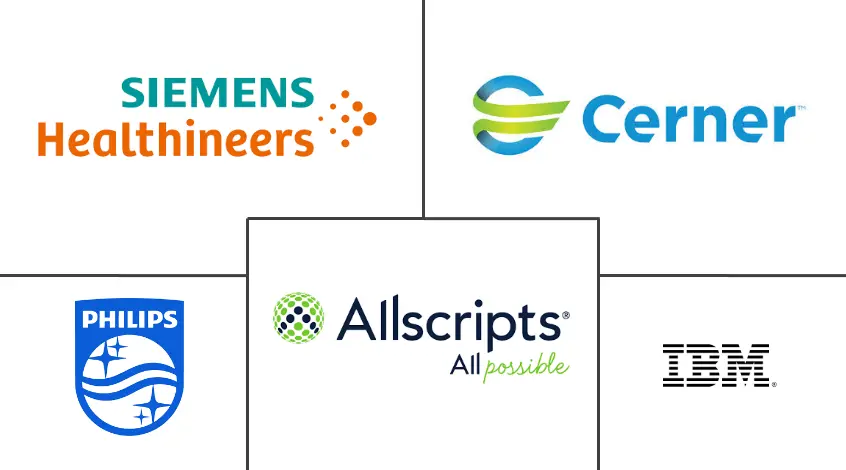Global Radiology Information Systems Market Size and Share
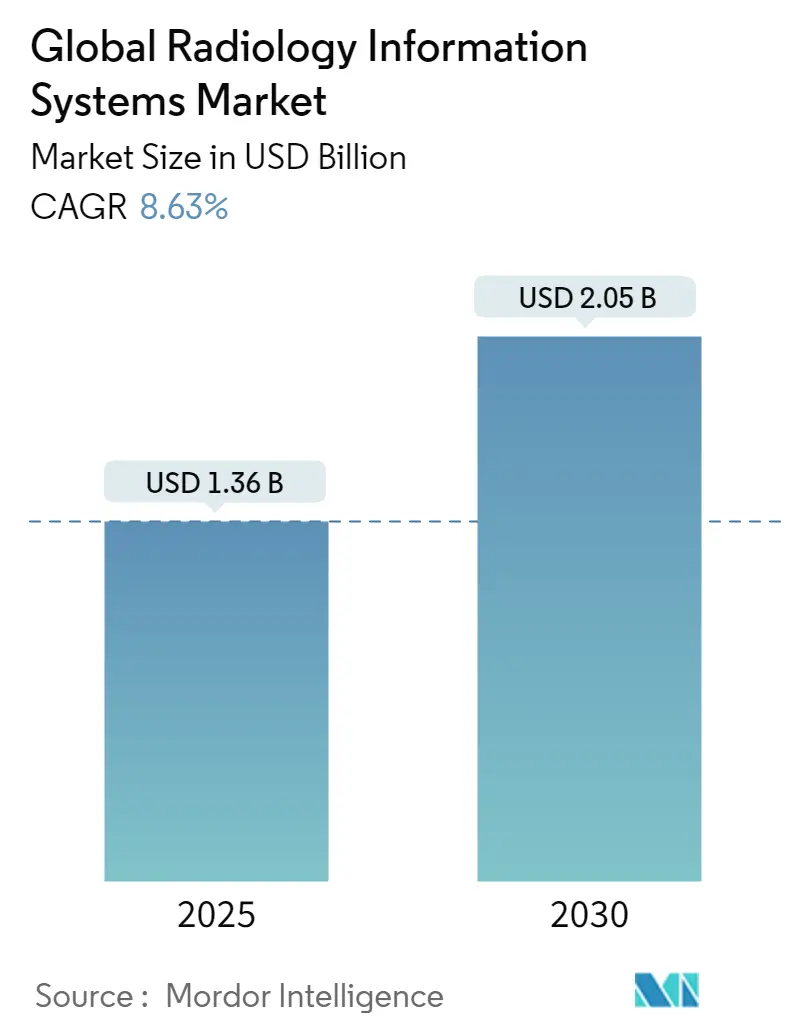
Global Radiology Information Systems Market Analysis by Mordor Intelligence
The radiology information system market reached USD 1.36 billion in 2025 and is forecast to climb to USD 2.11 billion by 2030 as it expands at a 9.12% CAGR. Growth is fueled by nationwide interoperability mandates, mounting radiologist shortages that amplify workflow pressures, and heightened cybersecurity requirements that encourage cloud-native architectures. Integrated enterprise platforms continue to dominate procurement decisions because they synchronize scheduling, reporting, and billing inside a unified record, yet stand-alone solutions are carving a niche in outpatient imaging and teleradiology networks that prefer modular, pay-as-you-go deployments. Cloud adoption is accelerating as providers seek scalable capacity and lower capital risk, even while many still rely on on-premise installations for data-sovereignty compliance. Vendors that bundle implementation services, AI-enabled analytics, and robust zero-trust security are best placed to win new contracts as hospitals re-platform antiquated infrastructure to meet real-time data-sharing rules.
Key Report Takeaways
- By type, integrated solutions led with 69.14% of the radiology information system market share in 2025, while stand-alone systems are projected to expand at a 9.65% CAGR through 2030.
- By deployment mode, on-premise deployments held 65.57% share of the radiology information system market size in 2025, and cloud-based options are forecast to grow at 9.81% CAGR to 2030.
- By component, software captured 45.85% of total 2025 revenue; services will grow the fastest at 10.14% CAGR through 2030.
- By end user, hospitals commanded 72.74% of industry revenue in 2025, while teleradiology providers record the highest projected CAGR at 9.84% to 2030.
Global Radiology Information Systems Market Trends and Insights
Driver Impact Analysis
| Driver | (~) % Impact on CAGR Forecast | Geographic Relevance | Impact Timeline |
|---|---|---|---|
| Escalating global burden of chronic diseases | +2.8% | Global, with highest impact in aging populations of North America, Europe, and Asia-Pacific | Long term (≥ 4 years) |
| Enterprise-wide digitization and tight integration with electronic health record | +2.1% | Global, led by North America and Europe regulatory requirements | Medium term (2-4 years) |
| Emerging interoperability mandates such as the US ONC Information-Blocking Rule and planned EU Health Data Space | +1.9% | North America and EU, with spillover to other regions adopting similar frameworks | Medium term (2-4 years) |
| Value-based-care incentives rewarding radiology throughput | +1.4% | Primarily North America, expanding to Europe and select Asia-Pacific markets | Long term (≥ 4 years) |
| National cancer-screening expansions (e.g., low-dose CT) | +1.2% | Global, with accelerated adoption in developed markets and emerging economies | Medium term (2-4 years) |
| Rise of teleradiology service aggregators in Tier-2/3 hospitals | +0.8% | Global, particularly impactful in rural and underserved regions | Short term (≤ 2 years) |
| Source: Mordor Intelligence | |||
Escalating Global Burden of Chronic Diseases
Cancer incidence is forecast to climb 42% by 2045, a trend that places sustained pressure on imaging throughput and information management [1]Nature Editorial Team, “Global Cancer Burden Outlook 2025,” Nature, nature.com. Hospitals and outpatient centers are deploying AI-ready RIS environments that catalogue rising study volumes and automate longitudinal follow-up, ensuring clinicians detect subtle disease progression early. The National Cancer Institute’s 2024 launch of a multi-cancer detection screening network covering 24,000 participants emphasizes why scalable data infrastructure is indispensable. Vendors now embed advanced analytics that flag risk cues hidden in prior images, improving personalized surveillance programs that align with value-based reimbursement.
Enterprise-wide Digitization and Tight Integration with Electronic Health Record
Seventy-two percent of health-system executives report tangible workflow gains from digital transformation initiatives that hinge on RIS-EHR convergence. Real-time image, order, and results exchange trims redundant data entry and lowers clerical error rates. Epic Systems grew to 39.1% EHR market share in 2023 and is building over 100 imaging-focused AI features to tighten informatics integration, illustrating how platform leaders create lock-in through seamless radiology modules. RIS suppliers complement these ecosystems with standardized FHIR APIs that preserve vendor differentiation through specialty-specific analytics.
Emerging Interoperability Mandates Such as the US ONC Information-Blocking Rule and Planned EU Health Data Space
The US Health IT Final Rule effective March 2024 requires algorithm transparency and cross-vendor data exchange that directly affects RIS specifications. July 2024 penalties for withholding radiology reports within 24 hours place financial risk on non-compliant providers. Europe’s Health Data Space regulation, adopted January 2025, mandates interoperable electronic health records across all EU states, expanding market opportunity for RIS platforms that meet rigorous privacy safeguards [2]Stella Kyriakides, “European Health Data Space: Empowering Citizens,” European Commission, ec.europa.eu. Vendors that ship robust audit trails and encryption stand to capitalize on multi-country rollouts.
Value-based-care Incentives Rewarding Radiology Throughput
Outcome-oriented payment models reward departments that cut turnaround times without sacrificing accuracy. CMS will require electronic prior authorization checks from 2027, incentivizing automated scheduling and decision support inside RIS workflows. Private imaging networks illustrate the commercial upside: SimonMed Imaging’s USD 40 AI breast-cancer program improved detection by 21% and unlocked premium reimbursement tiers. Providers now request predictive analytics that balance scanner utilization against staffing limits to maximize billable studies per day.
Restraint Impact Analysis
| Restraint | (~) % Impact on CAGR Forecast | Geographic Relevance | Impact Timeline |
|---|---|---|---|
| Escalating cybersecurity insurance premiums for imaging data | -1.8% | Global, with highest impact in North America and Europe due to regulatory scrutiny | Short term (≤ 2 years) |
| Large upfront licence fees, workflow re-engineering costs and interface work | -1.2% | Global, particularly affecting smaller healthcare organizations and emerging markets | Medium term (2-4 years) |
| Radiologist staffing shortages limiting system utilisation | -1.0% | Global, with acute impact in North America, Europe, and rural Asia-Pacific regions | Long term (≥ 4 years) |
| Data-sovereignty rules complicating multi-country cloud roll-outs | -0.7% | Global, with highest impact in Europe, China, and regions with strict data localization requirements | Medium term (2-4 years) |
| Source: Mordor Intelligence | |||
Escalating Cybersecurity Insurance Premiums for Imaging Data
Eighty-eight percent of providers endure at least one cyberattack yearly, and imaging archives are prized ransomware targets. The 2020 breach at University of Vermont Health Network triggered USD 63 million in losses and 39 days of downtime, highlighting the hidden cost of inadequate security controls. Insurers respond with steep premiums that inflate total cost of ownership. Cloud hyperscalers counter by bundling zero-trust features and managed detection services, yet data-residency rules keep some hospitals tethered to local data centers.
Large Upfront Licence Fees, Workflow Re-engineering Costs and Interface Work
Traditional RIS rollouts require six- or seven-figure licence fees, bespoke HL7 interfaces, and extensive staff retraining that push smaller hospitals to delay modernization. Integration with legacy PACS often demands custom code that extends projects beyond planned timelines. Cloud-native subscriptions ease capital shock, cutting total cost by as much as 30% according to diagnostic-imaging executives. The USD 30 million, seven-year Visage agreement with Duly Health and Care demonstrates predictable opex models that shift spend from CapEx budgets.
Segment Analysis
By Type: Integrated Solutions Drive Market Consolidation
Integrated platforms commanded 69.14% of 2025 revenue, proof that health-systems value a single vendor for registration, scheduling, worklist, and billing. Their economies of scale reduce interface maintenance and centralize governance. Stand-alone solutions grow at 9.65% CAGR because specialty imaging centers and teleradiology networks crave lightweight, cloud-first tools without the overhead of enterprise licensing. Vendor consolidation is accelerating as RIS suppliers embed advanced orchestration to attract enterprise buyers.
Epic Systems added 153 acute hospitals in 2023, while Oracle Health introduced AI-powered prior authorization that trims denials. These moves show that analytics is the new battleground. Nimbler firms counter with modular, API-centric designs that plug into mainstream EHRs, reducing the switching friction that once locked customers into monolithic stacks.
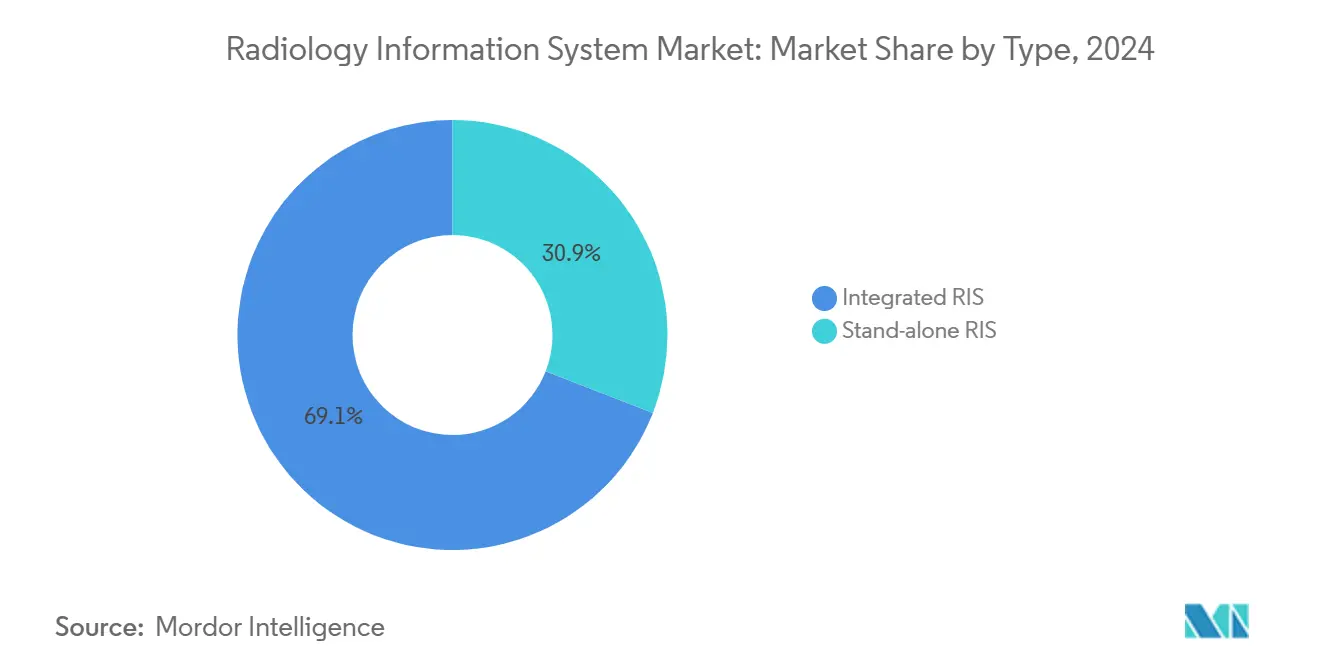
Note: Segment shares of all individual segments available upon report purchase
By Deployment Mode: Cloud Migration Accelerates Despite Security Concerns
On-premise installations still dominate at 65.57% because CTOs remain wary of off-site data storage mandates. Yet cloud subscriptions post 9.81% CAGR as CIOs prioritize elastic scaling and outsourced security. Providers spend USD 38 million per year on average for infrastructure contracts but only tap 44% of provisioned capacity, indicating headroom for optimization within the current spend envelope.
The COVID-19 emergency exposed vulnerabilities in fixed data centers when staff shifted to remote reading. Health-systems now hedge with hybrid models that burst excess load to the cloud during peak demand. Strategic alliances such as GE HealthCare with Amazon Web Services and Microsoft’s imaging cloud for Epic accelerate this transition by packaging compliance controls and regional data stores.
By Component: Services Growth Reflects Implementation Complexity
Software represented 45.85% of 2025 billings as facilities upgraded to workflow-centric versions with embedded analytics and natural-language report creation. Services, however, outpace every other line item at 10.14% CAGR. Hospitals hire consultants for gap analysis, change-management coaching, and cybersecurity hardening, underscoring that technology alone cannot guarantee operational gains.
Hardware demand is tapering because virtualization and browser-based workstations reduce the necessity for dedicated radiology consoles. Vendors respond with managed-service bundles that eliminate separate licensing, support, and hosting invoices, streamlining budgeting for finance teams under strain from reimbursement cuts.
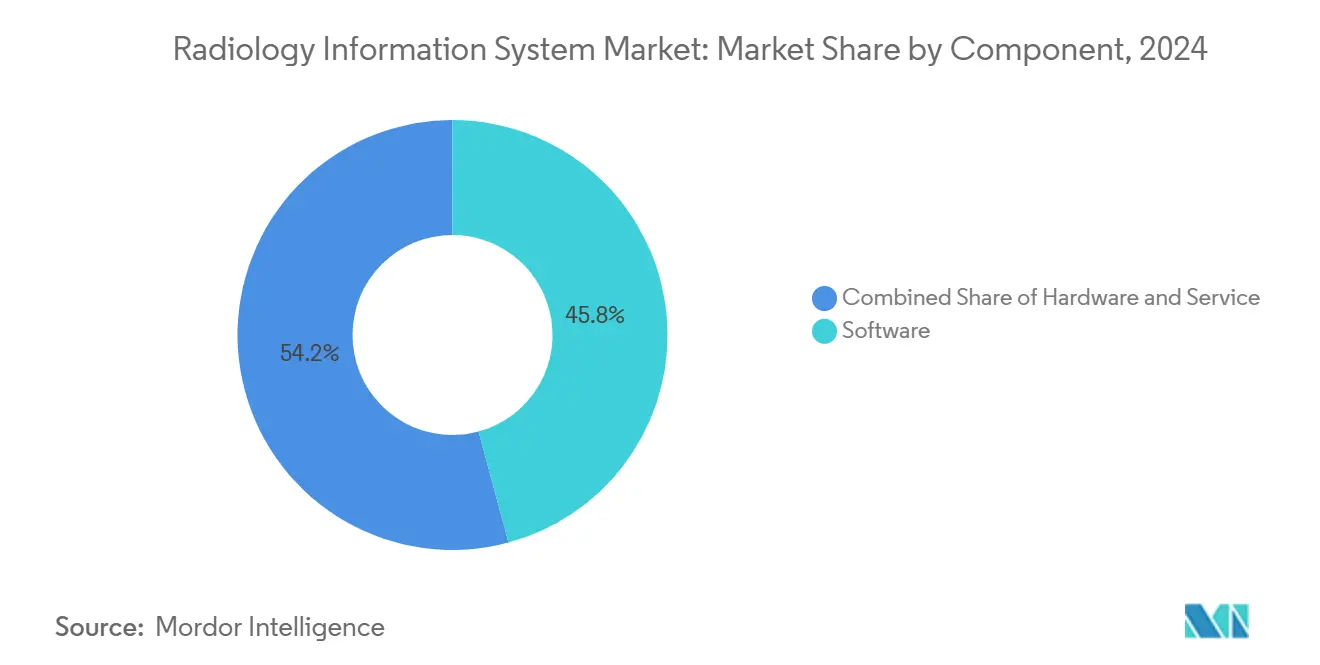
Note: Segment shares of all individual segments available upon report purchase
By End User: Teleradiology Providers Emerge as Growth Catalyst
Hospitals and multihospital systems absorbed 72.74% of RIS spending in 2025 as they rushed to unify enterprise imaging. Diagnostic imaging centers maintain steady out-patient traction, while ambulatory surgery centers create new demand for micro-PACS connectivity. Teleradiology firms expand the fastest at 9.84% CAGR by filling night-call gaps and offering subspecialty coverage across time zones.
ONRAD’s purchase of Direct Radiology from Philips produced the largest independent US teleradiology entity, proving scale economies matter in remote reading. Persistent radiologist shortages projected through 2055 magnify the need for unified platforms that route studies seamlessly among on-site and remote clinicians without breaking audit trails.
Geography Analysis
North America delivered 49.53% of 2025 worldwide revenue, buoyed by the 21st Century Cures Act and robust venture funding that bankrolls cloud pilots and AI trials. Sutter Health’s USD 1 billion imaging AI partnership typifies the investment scale. Mandatory 24-hour report release windows, enforced since July 2024, forced hospitals to overhaul legacy RIS queues, supporting incremental license upgrades.
Asia-Pacific is the fastest climber with a 10.34% CAGR. Japan’s DX program sets national quality standards for structured image data, encouraging hospital consortia to migrate to interoperable platforms [3]Shigeyuki Goto, “Medical DX Roadmap 2025,” Ministry of Health, Labour and Welfare Japan, mhlw.go.jp. China channels large public budgets into provincial cloud data centers, pushing demand for RIS that localize language yet maintain HL7 compatibility. India’s telehealth initiatives, laced with incentive payments for rural diagnostics, stimulate purchases of web-based RIS that adapt to low-bandwidth settings.
Europe’s regulatory landscape transformed in January 2025 when the European Health Data Space regulation took effect. The rule prescribes common data specifications that will be phased in through 2029, giving RIS vendors a defined roadmap for certification. GE HealthCare’s USD 249 million AI imaging deal with Nuffield Health covering 31 UK hospitals signals how providers are future-proofing infrastructure ahead of full EHDS enforcement.
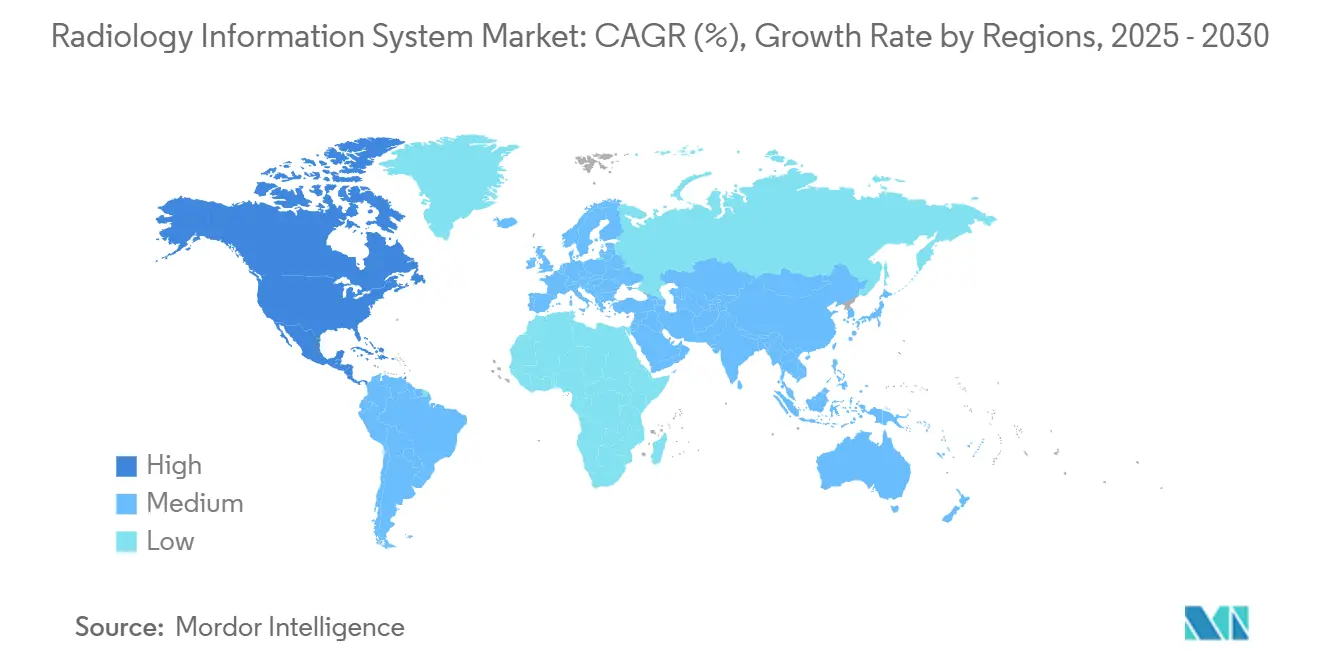
Competitive Landscape
The sector features moderate concentration as the ten largest suppliers account for roughly 55% of global revenue. Epic Systems, Oracle Health, and GE HealthCare leverage vast R&D budgets and installed EHR footprints to cross-sell imaging modules that ride existing interoperability gateways. Siemens Healthineers, Sectra, and INFINITT Healthcare compete on subspecialty workflow, embedded analytics, and high-availability cloud architectures.
Strategic alliances are replacing pure acquisitions. GE HealthCare partnered with RadNet to co-develop SmartTechnology solutions that fuse AI scheduling with patient-specific imaging protocols. Amazon’s investment in Aidoc’s multimodal foundation model exemplifies hyperscaler interest in domain-specific AI that accelerates large-language-model accuracy for radiology use cases. Private equity groups such as WindRose Health Investors aggregated RIS and PACS assets under Collaborative Imaging to build scale in managed-services contracts and strengthen negotiation power against large health-systems.
Emerging contenders focus on zero-trust cybersecurity, predicting ransomware risk scoring per study and offering hold-harmless indemnity. Others target low-cost, browser-only RIS aimed at ambulatory surgery centers that operate with thin IT teams. Competitive differentiation now hinges on balancing rapid cloud deployment, bulletproof compliance, and AI-powered productivity without escalating operating expenses.
Global Radiology Information Systems Industry Leaders
-
Allscripts Healthcare Solutions Inc.
-
Cerner Corporation
-
IBM (Merge Healthcare Incorporated)
-
Koninklijke Philips N.V.
-
Siemens Healthineers
- *Disclaimer: Major Players sorted in no particular order
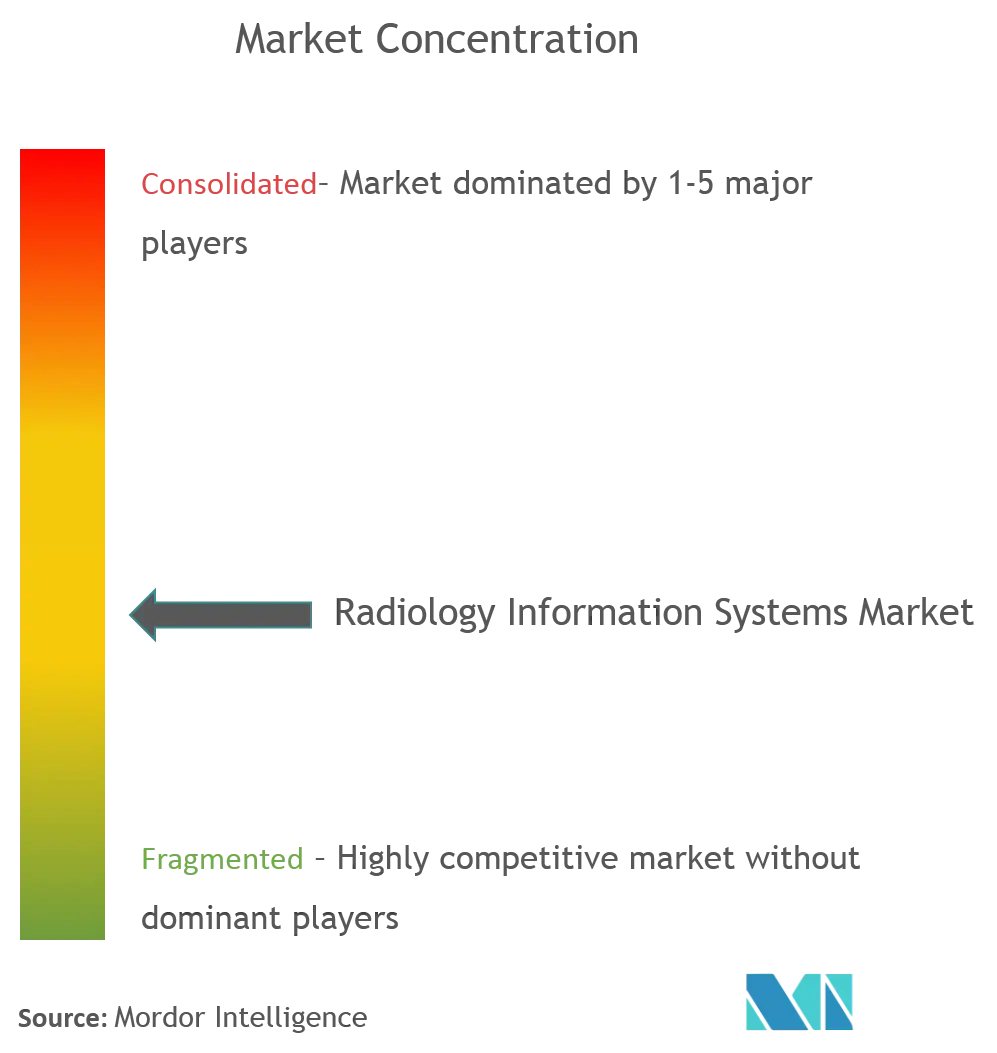
Recent Industry Developments
- July 2024: DeepHealth, a subsidiary of RadNet, opened a new office in Bengaluru to expand into the Indian market. This technology hub drives innovative advancements and supports DeepHealth’s mission to revolutionize care delivery.
- June 2024: DeepHealth launched its integrated portfolio in Italy. The cloud-native DeepHealth OS unifies clinical data and personalizes AI-powered workspaces to improve patient outcomes across lung, breast, prostate, and brain health.
- February 2024: Pro Medicus launched Visage Ease VP for Apple Vision Pro, delivering an immersive spatial imaging experience for diagnostic workflows.
Research Methodology Framework and Report Scope
Market Definitions and Key Coverage
Mordor Intelligence defines the Radiology Information Systems (RIS) market as purpose-built software that orchestrates patient scheduling, imaging workflow, results reporting, analytics, and billing inside diagnostic imaging departments, whether offered as a stand-alone suite or as a licensed module within enterprise imaging portfolios. The study values only software license, subscription, and linked implementation or support fees; hardware servers and unrelated hospital information-system modules are tracked elsewhere.
Scope exclusion: bundled RIS code that ships inside all-inclusive hospital information-system deals without discrete pricing is left outside the baseline.
Segmentation Overview
- By Type
- Integrated RIS
- Stand-alone RIS
- By Deployment Mode
- On-premise
- Cloud-based / Web-hosted
- By Component
- Hardware
- Software
- Services
- By End User
- Hospitals & Health Systems
- Diagnostic Imaging Centers
- Ambulatory Surgical Centers
- Teleradiology Providers
- By Geography
- North America
- United States
- Canada
- Mexico
- Europe
- Germany
- United Kingdom
- France
- Italy
- Spain
- Rest of Europe
- Asia-Pacific
- China
- Japan
- India
- South Korea
- Australia
- Rest of Asia-Pacific
- Middle East
- GCC
- South Africa
- Rest of Middle East
- South America
- Brazil
- Argentina
- Rest of South America
- North America
Detailed Research Methodology and Data Validation
Primary Research
Mordor analysts next interviewed RIS product managers, imaging-center IT heads, PACS administrators, and hospital buyers across North America, Europe, Asia-Pacific, and the Middle East. These discussions clarified average selling prices, module attach rates, and regional cloud-hosting preferences, sharpening assumptions lifted from secondary material.
Desk Research
Our analysts began with government datasets such as CMS Medicare Part B imaging claims, Eurostat procedure volumes, and Japan MHLW fee schedules, which anchor actual scan counts and reimbursement ceilings. Associations like the Radiological Society of North America, HIMSS, and the American College of Radiology provide adoption benchmarks for interoperability, cloud migration, and security frameworks. Company 10-Ks and investor decks help us follow pricing pivots toward SaaS and managed services, while scholarly journals in the Journal of Digital Imaging outline emerging AI-enabled workflow modules. Paid libraries, D&B Hoovers for vendor financials and Dow Jones Factiva for deal tracking, fill revenue gaps. This list is illustrative; many additional public and subscription sources informed the desk phase.
Market-Sizing & Forecasting
We reconstruct the 2025 baseline through a top-down lens. Diagnostic imaging procedure volumes are multiplied by verified RIS penetration rates, then adjusted to reflect on-premise versus cloud ASP differentials. Supplier roll-ups and sampled contract checks supply a bottom-up reasonableness test before totals are locked. Key variables include annual CT/MRI exam counts, hospital EHR penetration, average license price erosion, cloud-hosting costs per study, regulatory incentives for interoperability, and AI add-on attach rates. Multivariate regression relates these drivers to historical spending and projects through 2030; scenarios vetted with primary experts temper extreme outliers.
Data Validation & Update Cycle
Outputs run through variance scans against independent scan-volume series and vendor earnings. An analyst peer reviews anomalies before sign-off. We refresh models every twelve months and trigger interim adjustments for material mergers, reimbursement changes, or cybersecurity mandates, ensuring clients always receive a current view.
Why Mordor's Radiology Information Systems Baseline Commands Confidence
Published RIS estimates rarely match, and differences usually stem from scope, pricing, and data-refresh cadence. Our disciplined inclusion of only monetized RIS software and service lines, plus annual model resets, minimizes hidden inflation.
Key gap drivers include some publishers folding generic imaging IT or server hardware into RIS totals, others assuming flat license fees despite evident SaaS discounts, and a few basing growth on historical five-year averages without fresh procedure data.
Benchmark comparison
| Market Size | Anonymized source | Primary gap driver |
|---|---|---|
| USD 1.36 B (2025) | Mordor Intelligence | - |
| USD 1.34 B (2024) | Global Consultancy A | Includes legacy server hardware and uses constant ASPs |
| USD 1.40 B (2024) | Regional Consultancy B | Treats bundled HIS-embedded RIS code as standalone revenue |
Taken together, the comparison shows that Mordor's bottom-checked, variable-driven model yields a transparent, repeatable baseline that decision-makers can trust for planning and investment discussions.
Key Questions Answered in the Report
How big is the Global Radiology Information Systems Market?
The Global Radiology Information Systems Market size is expected to reach USD 1.36 billion in 2025 and grow at a CAGR of 8.63% to reach USD 2.05 billion by 2030.
Which solution segment currently commands the largest market share?
Integrated radiology information systems lead with 69.14% global revenue share in 2025, reflecting hospital demand for end-to-end workflow platforms.
Who are the main competitors in the radiology information system landscape?
Key vendors include Epic Systems, Oracle Health, GE HealthCare, Siemens Healthineers, Sectra, INFINITT Healthcare, and a cohort of focused teleradiology and cloud-native specialists that supply modular, API-driven solutions.
Which is the fastest growing region in Global Radiology Information Systems Market?
Asia Pacific is estimated to grow at the highest CAGR over the forecast period (2025-2030).
Which region has the biggest share in Global Radiology Information Systems Market?
In 2025, the North America accounts for the largest market share in Global Radiology Information Systems Market.
Why are healthcare providers increasingly adopting cloud-based RIS deployments?
Cloud subscriptions offer scalable capacity, lower upfront capital outlay, embedded cybersecurity safeguards, and easier disaster-recovery options—all critical as imaging volumes rise and data-sharing mandates tighten.
Page last updated on:
